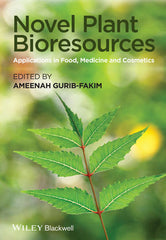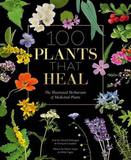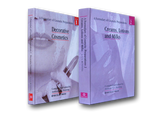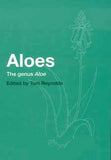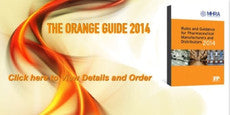Novel Plant Bioresources: Applications in Food, Medicine and Cosmetics By Ameenah Gurib-Fakim (Editor)
Novel Plant Bioresources: Applications in Food, Medicine and Cosmetics
April 2014
Novel Plant Bioresources: Applications in Food, Medicine and Cosmetics serves as the definitive source of information on under-utilized plant species, and fills a key niche in our understanding of the relationship of human beings with under-utilized plants. By covering applications in food, medicine and cosmetics, the book has a broad appeal.
In a climate of growing awareness about the perils of biodiversity loss, the world is witnessing an unprecedented interest in novel plants, which are increasingly prized for their potential use in aromas, dyes, foods, medicines and cosmetics. This book highlights these plants and their uses. After an introductory section which sets the scene with an overview of the historical and legislative importance of under-utilized plants, the main four parts of the book are dedicated to the diverse potential application of novel plant bioresources in Food, Medicine, Ethnoveterinary Medicine and Cosmetics.
Examples and contributors are drawn from Africa, Europe, the USA and Asia. The economic, social, and cultural aspects of under-utilized plant species are addressed, and the book provides a much needed boost to the on-going effort to focus attention on under-utilized plant species and conservation initiatives. By focusing on novel plants and the agenda for sustainable utilization, Novel Plant Bioresources highlights key issues relevant to under-utilized plant genetic resources, and brings together international scholars on this important topic.
List of contributors xiii
Foreword xvii
PART ONE NOVEL PLANT BIORESOURCES: APPLICATIONS IN MEDICINE, COSMETICS, ETC. 1
1 Plant Diversity in Addressing Food, Nutrition and Medicinal Needs 3
M.E. Dulloo, D. Hunter and D. Leaman
1.1 Introduction 3
1.2 Plant genetic resources for food and agriculture 7
1.3 Plant genetic diversity for nutrition 10
1.4 Plant diversity for medicines 14
2 World Health Organization Perspective for Traditional Medicine 23
Ossy M. J. Kasilo and Jean-Baptiste Nikiema
2.1 Introduction 23
2.2 Policies on traditional medicine 24
2.3 Tools and guidelines 24
2.4 Implementation of the regional strategy on traditional medicine 35
2.5 The way forward 40
2.6 Conclusion 41
3 Cultivation of Novel Medicinal Plant Products and Associated Challenges 43
Ulrich Feiter
3.1 Introduction 43
3.2 Basic principles of novel crop cultivation 43
3.3 Case study 1: Pelargonium sidoides 51
3.4 Case study 2: Sutherlandia frutescens 52
3.5 Case study 3: Euphorbia resinifera 54
3.6 Conclusion 55
4 Enabling Technologies to Facilitate Natural Product-Based Drug Discovery from African Biodiversity 57
Nyaradzo, T., L. Chigorimbo-Murefu, Grace Mugumbate and Kelly Chibale
4.1 Introduction 57
4.2 Enabling-technology platforms 59
4.3 Natural product diversification and drug metabolite generation platform 65
4.4 Conclusion 65
5 Assessing Biodiversity: A Molecular Approach Using DNA Sequencing 69
Yasmina Jaufeerally-Fakim
5.1 Introduction 69
5.2 Taxonomy and evolution 69
5.3 Assessing diversity 70
5.4 DNA sequencing and barcoding 73
5.5 Plant genomics 75
5.6 Analysis of marker data 79
6 Conservation of Endangered Wild Harvested Medicinal Plants: Use of DNA Barcoding 81
Sarina Veldman, Joseph Otieno, Barbara Gravendeel, Tinde van Andel and Hugo de Boer
6.1 Wild harvested medicinal plants: background and challenges 81
6.2 DNA barcoding general 82
6.3 DNA barcoding and species delimitation 82
6.4 DNA barcodes for plants 83
6.5 Examples of DNA barcoding of cryptic and prepared plant material 83
6.6 Plant DNA authentication, verification and certification 85
6.7 Future opportunities and challenges 85
7 Market Entry, Standards and Certification 89
Susan A. Wren
7.1 Sustainable utilization of indigenous plant products 89
7.2 Market entry 90
7.3 Certification 93
7.4 Developing indigenous plant-based enterprises as viable businesses with developing country communities 102
8 European Union Market Access Categories and Regulatory Requirements for Novel Natural Products 107
Thomas Brendler and L. Denzil Philipps
8.1 Introduction 107
8.2 Raw materials 107
8.3 Finished products 111
8.4 Summary 122
9 Nutrition, Health and Food Security: Evidence and Priority Actions 125
L. J. Ferrao and T. H. Fernandes
9.1 Introduction 125
9.2 Well-being and nutrition 125
9.3 Traditional food cultures 126
9.4 Nutrition in pregnancy and infancy 126
9.5 Health and nutrition education is central for development 127
9.6 Research and development 128
9.7 Role of agricultural growth on reducing poverty, hunger and malnutrition 128
9.8 Concluding remarks 129
PART TWO MEDICINE (PLANTS AS MEDICINE: HUMANS AND ANIMAL HEALTH) 131
10 Anticancer Potential of African Plants: The Experience of the United States National Cancer Institute and National Institutes of Health 133
John A. Beutler, Gordon M. Cragg, Maurice Iwu, David J. Newman and Christopher Okunji
10.1 Introduction 133
10.2 The United States National Cancer Institute programme 133
10.3 The International Cooperative Biodiversity Groups programme 139
10.4 Conclusions 145
11 Biodiversity as a Source of Potent and Selective Inhibitors of Chikungunya Virus Replication 151
Pieter Leyssen, Jacqueline Smadja, Philippe Rasoanaivo, Ameenah Gurib-Fakim, Mohamad Fawzi Mahomoodally, Bruno Canard, Jean-Claude Guillemot, Marc Litaudon and Francoise Gueritte
11.1 The epidemiology of chikungunya virus 151
11.2 The PHYTOCHIK programme for the discovery of natural compounds active against chikungunya virus 154
11.3 Euphorbiaceae, abundant source of anti-chikungunya virus compounds 157
11.4 Conclusion 159
12 Using African Plant Biodiversity to Combat Microbial Infections 163
J. N. Eloff and L. J. McGaw
12.1 Introduction and problem statement 163
12.2 Commercial use of African medicinal plants in the herbal medicine industry 164
12.3 Why is there such a difference in product development for antimicrobials versus other medicinal applications? 164
12.4 Methods used in developing useful products 164
12.5 Results of random screening of large number of species 167
12.6 Our approach to random screening 168
12.7 Activity of compounds isolated against Staphylococcus aureus 169
12.8 Discovering antifungal compounds from natural products 169
12.9 Review papers focusing on antimicrobial activity of plants from Africa 169
12.10 Promising new approaches 170
12.11 The potential of using African medicinal plants as extracts 170
12.12 Conclusions 171
13 Plant Medicines Used in the Treatment of Malaria 175
John R.S. Tabuti, Antonia Nyamukuru and Mohammed Lamorde
13.1 Introduction 175
13.2 Approach used in the review 175
13.3 Plant species commonly used to treat malaria in Uganda 176
13.4 Conclusions and recommendations 177
14 Multiple Anti-Infective Properties of Selected Plant Species from Zimbabwe 179
Rumbidzai Mangoyi, Tariro Chitemerere, Theresa Chimponda, Elaine Chirisa and Stanley Mukanganyama
14.1 Introduction 179
14.2 Preparation of plant extracts 181
14.3 Conclusions 188
15 Development of Phytodrugs from Indigenous Plants: The Mali Experience 191
Rokia Sanogo
15.1 Introduction 191
15.2 Development of new phytodrugs 198
15.3 Discussion 199
15.4 Conclusion 200
16 Healing Aloes from the Mascarenes Islands 205
Joyce Govinden-Soulange
16.1 Introduction 205
16.2 The Asphodelaceae 205
16.3 Prospects and research avenues 211
17 Pharmacological Activities of Some of the Neglected and Underutilized Tropical Plants in Malaysia 215
Z.A. Zakaria, F. Yahya, T. Balan, S.S. Mamat, R. Rodzi, F.H. Kamisan, C.A. Fatimah and A.L. Ibrahim
17.1 Introduction 215
17.2 Muntingia calabura 215
17.3 Dicranopteris linearis 218
17.4 Bauhinia purpurea 219
17.5 Melastoma malabathricum 222
17.6 Conclusion 224
18 Multiple Applications of Endophytic Colletotrichum Species Occurring in Medicinal Plants 227
Mahendra Rai, Gauravi Agarkar and Dnyaneshwar Rathod
18.1 Introduction 227
18.2 Diversity of endophytic Colletotrichum sp. in medicinal plants 228
18.3 Biomedical applications 228
18.4 Agriculture applications 231
18.5 Industrial applications 233
18.6 Perspectives 234
18.7 Conclusion 234
19 African Plants with Potential for Development into Ethnoveterinary Products 237
L.J. McGaw and J.N. Eloff
19.1 Introduction 237
19.2 What is ethnoveterinary medicine? 237
19.3 Ethnoveterinary medicine in Africa 238
19.4 African plants as sources of commercial remedies 255
19.5 Examples of African medicinal plants used for ethnoveterinary purposes with scope for commercialization 256
19.6 Toxicity 258
19.7 Conclusions 258
20 African Plant Biodiversity in Pest Management 263
S. N'Danikou, D.A. Tchokponhoue, C.A. Houdegbe and E.G. Achigan-Dako
20.1 Introduction 263
20.2 History of humans’ use of plant biodiversity in pest management 264
20.3 Methods and approaches in pest management 264
20.4 Research on plant use in pest management 266
20.5 Biodiversity of African plants used in pest management 267
20.6 Benefits of the use of plants in crop pest management 270
20.7 Limits of the study 270
20.8 Conclusion 270
21 Commercialization of Ethnoveterinary Botanical Products 285
David R. Katerere
21.1 Introduction 285
21.2 Therapeutic areas for ethnoveterinary applications 287
21.3 Conclusion 290
22 Plants Used for Pest Management in Malawi 295
Cecilia Maliwichi-Nyirenda, Lucy Lynn Maliwichi and John F. Kamanula
22.1 Introduction 295
22.2 Merits and demerits of pest management systems in Malawi 296
22.3 Plant species used in pest management 297
PART THREE FOOD (SPICES, FRUIT AND VEGETABLES, ETC.) 303
23 Aromatic Plants: Use and Nutraceutical Properties 305
Lucia Guidi and Marco Landi
23.1 Introduction 305
23.2 Mediterranean aromatic plants 307
23.3 Concluding remarks 325
24 'Let Your Food Be Your Medicine': Exotic Fruits and Vegetables as Therapeutic Components for Obesity and Other Metabolic Syndromes 347
Mohamad Fawzi Mahomoodally
24.1 Introduction 347
24.2 Obesity, diabetes and metabolic syndromes 347
24.3 Medicinal food plants against metabolic diseases 348
24.4 Conclusion 355
25 Strategic Repositioning African Indigenous Vegetables and Fruits with Nutrition, Economic and Climate Change Resilience Potential 361
M.O. Abukutsa-Onyango
25.1 Introduction 361
25.2 African indigenous vegetables and fruits 362
25.3 Strategic repositioning of indigenous vegetables and fruits in the horticulture 364
25.4 Concluding remarks 367
26 Hepatoprotective, Antiulcerogenic, Cytotoxic and Antioxidant Activities of Musa acuminata Peel and Pulp 371
Fatimah Corazon Abdullah, Lida Rahimi, Zainul Amiruddin Zakaria and Abdul Latif Ibrahim
26.1 Introduction 371
26.2 Hepatoprotective activity 373
26.3 Antiulcerogenic activity 377
26.4 Cytotoxic activity 379
26.5 Antioxidant activity 380
26.6 Conclusion 381
27 Plant Bioresources and their Nutrigenomic Implications on Health 383
Maznah Ismail and Mustapha Umar Imam
27.1 Introduction 383
27.2 Plant bioresources for health uses: beyond traditional uses 384
27.3 Bioactivity of plant bioresources: nutrigenomic implications 384
27.4 Potential implications of the rising trend in the use of plant bioresources for remedies 390
27.5 Conclusions 390
28 Safety of Botanical Ingredients in Personal Healthcare: Focus on Africa 395
R. Vihotogbe, C.N.A. Sossa-Vihotogbé and G.E. Achigan-Dako
28.1 Introduction 395
28.2 Safety in healthcare via food consumption 395
28.3 Medicinal plants in healthcare 396
PART FOUR COSMETICS (INCLUDING DYES, AROMAS) 409
29 Aromatic and Medicinal Plants in North Africa: Opportunities, Constraints and Prospects 411
Mohamed Ghanmi, Abderrahman Aafi, Badr Satrani, Mohamed Aberchane, Abderrahim Khia and Salah Eddine Bakkali Yakhlef
29.1 Introduction 411
29.2 Aromatic and medicinal plants in North Africa: a snapshot on the countries of the Maghreb (Morocco, Algeria and Tunisia) 411
29.3 Aromatic and medicinal plants in North Africa: overview and prospects 413
29.4 Aromatic and medicinal plants in Morocco: opportunities, constraints and prospects 413
29.5 Development of the aromatic and medicinal plants sector in Morocco: the strategy adopted 415
29.6 Research conducted in the field of aromatic and medicinal plants: achievements and prospects 415
29.7 Medicinal and aromatic plants in Algeria 417
29.8 Medicinal and aromatic plants in Tunisia 418
29.9 Molecular techniques as tools for conservation and valorization of aromatic and medicinal plants 418
29.10 Sector of aromatic and medicinal plants in North Africa: prospects 421
30 Development of Natural Cosmeceuticals: Harnessing Asia's Biodiversity 425
Azila Abdul-Aziz, Mariani Abdul Hamid, Norhayati Mohammad Noor, Harisun Yaakob, Rosnani Hasham and Mohamad Roji Sarmidi
30.1 Introduction 425
30.2 Mangosteen: a 'fruity' depigmenting agent 425
30.3 Ficus deltoidea: the ‘golden’ treasure from nature 426
30.4 Labisia pumila: Malaysia’s queen of herbs 427
30.5 Andrographis paniculata: a ‘bitter’ therapy for the skin 428
30.6 Centella asiatica: herbs' jack of all trades 429
30.7 Future trends 429
31 Unique Bioresources from Ethiopia for Food, Medicine and Cosmetics 433
E. Dagne
31.1 Introduction 433
31.2 Boswellia species (Burseraceae), etan (Amharic) 433
31.3 Catha edulis (Celastraceae), khat 433
31.4 Coffea arabica (Rubiaceae), buna (Amharic) 434
31.5 Commiphora myrrha (Burseraceae), kerbe (Amharic) 435
31.6 Croton macrostachyus (Euphorbiaceae), bissana (Amharic) 435
31.7 Echinops kebericho (Asteraceae), kebericho (Amharic) 435
31.8 Ensete ventricosum (Musaceae), enset (Amharic) 436
31.9 Eragrostis tef (Poaceae), tef (Amharic) 436
31.10 Hagenia abyssinica (Rosaceae), koso (Amharic) 438
31.11 Moringa stenopetala (Moringaceae), shiferaw (Amharic) 438
31.12 Nigella sativa (Ranunculaceae), tikur azmud (Amharic) 439
31.13 Phytolacca dodecandra (Phytolaccaceae), endod (Amharic) 439
31.14 Sorghum bicolor (Poaceae), mashla (Amharic) 439
31.15 Taverniera abyssinica (Leguminosae), dingetegna (Amharic) 440
31.16 Civettictis civetta: source of civet zebad (Amharic) 440
31.17 Conclusion 440
32 Aromatic Plants from Reunion Island (France) 443
Anne Bialecki and Jacqueline Smadja
32.1 Introduction 443
32.2 Aromatic plant production: economic data 443
32.3 Extraction techniques used in Reunion Island 444
32.4 Analysis of essential oils and plant headspace in the Chemistry Laboratory of Natural Substances and Food Sciences 445
32.5 Identification of volatile compounds at the Chemistry Laboratory of Natural Substances and Food Sciences 446
32.6 Conclusion 451
33 Anti-Parasitic Activity of Essential Oils and their Active Constituents against Plasmodium, Trypanosoma and Leishmania 455
Joanne Bero, Salomé Kpoviessi and Joëlle Quetin-Leclercq
33.1 Introduction 455
33.2 Essential oils 455
33.3 Compounds isolated from essential oils 460
33.4 Discussion and conclusion 460
34 Metabolomic Analysis of a Commercially Important Aromatic Plant from the Indian Ocean: Vanilla planifolia 471
Tony L. Palama
34.1 Introduction 471
34.2 Vanilla description 471
34.3 Vanilla metabolomics 473
34.4 Other future prospects 475
34.5 Conclusions 476
35 Natural Dyes for Photonics Applications 479
M. Maaza
35.1 Introduction 479
35.2 Nonlinear optical properties of natural dyes: X(3) and optical limiting applications 479
35.3 Linear optical properties of natural dyes: Gratzel dye solar cells 485
35.4 Conclusion 491
36 The Host Innate Immune Response to Propionibacterium acnes and the Potential of Natural Products as Cosmeceutical Agents 495
Marco Nuno de Canha, Smeetha Singh and Namrita Lall
36.1 The skin and its function 495
36.2 The impact of skin disorders with focus on acne 495
36.3 Propionibacterium acnes: is it the culprit? 495
36.4 Acne vulgaris (acne) 496
36.5 The activation of innate and adaptive immune system 497
36.6 The host immune response to infection by Propionibacterium acnes 498
36.7 Conventional treatments available for acne vulgaris 499
36.8 Potential of natural products to treat acne vulgaris 500
36.9 The importance of the emergence of plant life on Earth 501
36.10 A proposed stepwise approach from plant extract to cosmeceutical product 501
37 New Natural Aromatic Products: Search, Evaluation and the Development Issues 507
Murray Hunter
37.1 Introduction 507
37.2 The family of natural aromatic extracts 507
37.3 The search and screening process 508
37.4 Sources of potential plant opportunity identification 509
37.5 The characteristics and classification of natural aromatic materials 510
37.6 Evaluating the characteristic strengths and weaknesses of natural aromatic materials 512
37.7 The development issues 512
37.8 Conclusion 522
Index 525
Ameenah Gurib-Fakim is Professor and Managing Director at the Centre for Phytotherapy Research (CEPHYR) in Mauritius. She has authored several books on medicinal plants and on the flora of Mauritius and Africa and has received several international prizes. In 2013, she receives the Honorary Doctorate from the Universite Pierre Marie Curie (Sorbonne Universites) and is also Honorary Professor at UNISA, Pretoria, South Africa
Related Products
-
100 Plants That Heal: The Illust...
1,700.00
2,000.00 -
A Formulary of Cosmetic Prepara...
14,000.00
-
A Textbook of Modern Toxicology,...
8,942.00
10,520.00 -
Aesthetics Exposed: Mastering Sk...
17,000.00
-
Aloes: The Genus Aloe edited by ...
2,446.00
2,795.00 -
Analysis of Cosmetic Products E...
2,195.00
- Architecture & Construction Management Books
- Biochemistry, Bioengineering and Biotechnology Books
- Books on Analytical Techniques, GC MS, LC, TLC, HPLC, NMR Spectroscopy
- Books on Water and Wastewater Treatment, Analysis Water Treatment Plants
- Chemical Technology, Organic Chemistry, Chemical Synthesis and Chemical Analysis Books
- Cosmetics Science, Cosmetics Formulations, Manufacture and their Analysis Books
- Drugs and Pharma Science Books
- Essential Oils, their Analysis, Natural Products Extraction, Distillation , Isolates Related Books
- Flavor Science, Flavor Analysis, Flavor Creation, Food Flavors Books
- Food Science and Technology, Baking , Food Ingredients , Food Quality , Food Regulations
- Formulations of Perfumes for Agarbatti, Air Freshners, Soaps & Detergents, Fabric Softeners , French style Perfumes, Attars , OUD, Fine Fragrances
- Fragrances, Scents, Attars , Perfumery and Aroma Chemicals Books
- Herbal, Ayurvedic, Medicinal Plants and Aromatic Plants Books
- Law Books
- Major Reference Works (MRWS) Sets - MultiVolume Sets
- Medical Books
- Medical Journals Wolters Kluwer | Medknow India
- NEW ARRIVALS
- Perfumer's Resources
- Special Indian Reprint !



